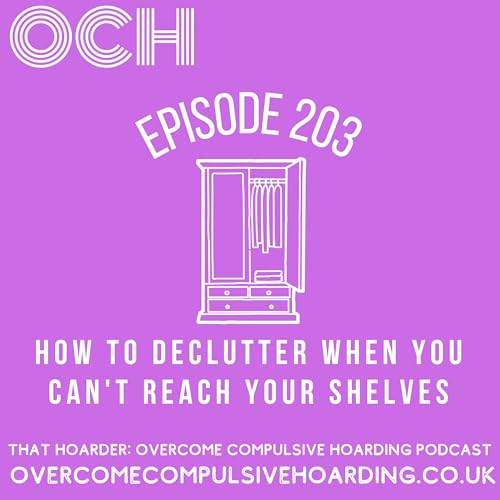Come to a Dehoarding Accountability Zoom Session: http://www.overcomecompulsivehoarding.co.uk/ticketSubscribe to the podcast: https://www.overcomecompulsivehoarding.co.uk/subscribePodcast show notes, links and transcript: http://www.overcomecompulsivehoarding.co.uk/ This episode, I’ve pulled together the best mental health advice from every guest I spoke to over the past year - academics, therapists, organisers, and people with lived experience. Each of them shared a personal habit or practice that genuinely helps them cope or keep on top of their wellbeing, and I add a couple of my own strategies too. Whether you’re navigating hoarding, supporting someone who is, or just looking for affordable ways to protect your own mental health, stick around for a mix of practical, honest tips to try for yourself. Special Episode Format: Compilation of Guest AdviceThroughout the year, every guest was asked about habits or practices supporting their mental health.Guest Contributions: Mental Health Habits and PracticesHarriet Impey (Episode 172)Mindfulness and meditation, especially mindful self-compassion (inspired by Kristin Neff).Practical examples: Being present, guided meditation, practicing non-attachment, and self-reflection on letting go of unhelpful arguments.Dr Jan Eppingstall (Episodes 174 & 204)Practicing gratitude to counterbalance negativity bias.Unsubscribing from unwanted emails to reduce anxiety and overwhelm.Interacting with pets for grounding and emotional well-being - petting animals as a stress reliever.Visiting places where animals are accessible (e.g., city farms, pet shops, animal cafes).Jasmine Sleigh (Episode 175)Importance of good sleep for mental health.Value of pleasurable activities like reading, and the paradox of sometimes resisting enjoyable activities (self-sabotage).Reflection on how engaging in enjoyable pastimes is essential even when it's difficult to get started.Sam (Episode 178)Writing things down: Keeping lists of achievements and things to be grateful for, even small joys.Acknowledging how gratitude doesn’t have to be grand - simple moments count.Exercise, particularly running, or any activity that gets you outside of your current headspace (could be walking, volunteering, etc.).The role of support from others to prompt new perspectives or activities.Dr. Victoria Ruby-Granger (Episode 179)Self-awareness and accepting what works for you, rather than trying to fit yourself to methods that don’t suit.Emphasis on letting go of approaches that don’t align with your own needs, and being open to alternative strategies.Carrie Lagerstedt (Episode 183)Moral neutrality: Separating self-worth from issues like executive dysfunction, lateness, and messiness.Reframing these traits as value-neutral rather than personal failings, helping to build self-esteem.That HoarderCreative self-expression: Resentful journaling, collage, and visual arts—done primarily for personal expression, not for others’ approval.Permission for creative works to be imperfect and focused on process over outcome.Nature connection: Getting outside, paying attention to natural details (flowers, leaves, colours, wildlife), and practicing mindful observation to foster grounding and perspective.Importance of self-compassion, giving oneself credit for small achievements (especially with meditation or walks).Allowing yourself pleasurable, nurturing, or healing activities without guilt.Noticing the bigger world and natural cycles as a counter to internal struggles.Encouragement for listeners to reflect on which practices resonate and to share their own tips. Links Podcast ep 172: Harriet Impey on clearing out her parents’ very full home, through family belongings and personal growth, in the film Where Dragons LivePodcast episode 174: How to feel grounded when we’re overwhelmed or dysregulated using ventral vagal spaces and touchstones, with Dr Jan EppingstallPodcast ep 175: Taking the scary first steps: the courage to call a professional organiser, with Jasmine SleighPodcast ep 178: Growing up in a hoarded home: Sam’s story as the child of a Mum who hoardsPodcast ep 179: How hoarding behaviours develop and early intervention for hoarding disorder, with Dr Victoria Ruby-GrangerPodcast ep 183: ADHD, executive dysfunction and creating hacks and systems to reduce clutter chaos, with Carrie LagerstedtPodcast ep 204: Am I my things? When possessions define us: the psychological connection between identity, self-concept and hoarding with Dr Jan EppingstallCome to a Dehoarding Accountability Zoom session: Accountability Booking FormWebsite: Overcome Compulsive HoardingBecome a Dehoarding DarlingSubmit a topic for the podcast to coverQuestions to ask when dehoarding: https://www.overcomecompulsivehoarding.co.uk/podquestionsInstagram: @thathoarderpodcastTwitter: @ThatHoarderMastodon: @ThatHoarder@mastodon.onlineTikTok: @thathoarderpodcastFacebook: Overcome Compulsive Hoarding with That HoarderPinterest: That ...
Show More
Show Less
 46 mins
46 mins 53 mins
53 mins 1 hr and 4 mins
1 hr and 4 mins 39 mins
39 mins 1 hr and 21 mins
1 hr and 21 mins 27 mins
27 mins Nov 1 202544 mins
Nov 1 202544 mins 44 mins
44 mins
